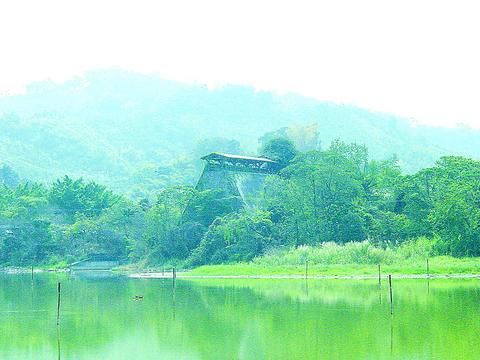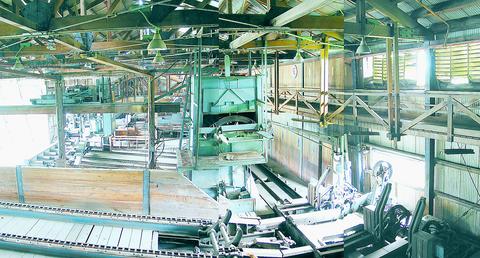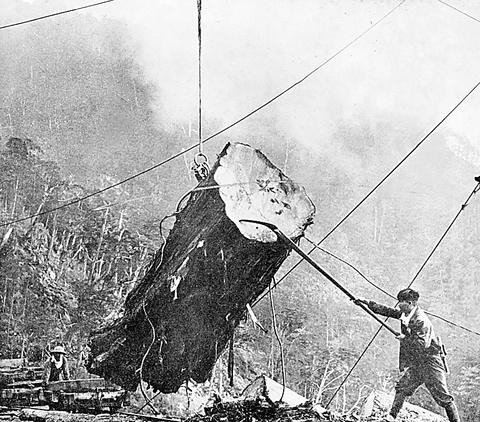In the small township of Tungshih (
Ironically, the move to have the logging station made into a museum had its inspiration in a recent major disaster, namely the 921 Earthquake, which devastated much of central Taiwan. Tungshih was one of the heaviest-hit areas on the island. More than 300 lives were lost, hundreds were injured and numerous houses ruined. Volunteers were brought in to help -- one of these was Yen Ming-hung (
The vast and somewhat dilapidated shelter where he worked covered more than 18 hectares. The buildings used to house the offices and factories of the Tahsue Mountain Forestry Company (大雪山林業公司), which was a major lumber company in the 1960s.

PHOTO COURTESY OF YEN MING-HUNG
The forestry company had come into existence in early 1959, using US government aid and designs by a Seattle, Washington company. At the time, it was state-of-the-art. But after about 10 years, it was forced to close down, a victim of management problems that included embezzlement and lumber theft. Thereafter, it sat idle for 30 years, isolated in the quiet, conservative and yet culturally rich Hakka township.
Changing policies
Shieh Shang-ta (

PHOTO COURTESY OF YEN MING-HUNG
Prior to this, the KMT government had followed the example of the Japanese colonial government in bringing in much-needed foreign exchange with massive exports of cypress and other high-value timber. Taiwan yellow cypress, which holds claim to be the best of the seven types of cypress, now costs approximately NT$70,000 per cubic meter.
One report indicates that the island of Taiwan once possessed around 20,000 hectares of natural cypress forest. Grown over hundreds of years, some of the giant trees are over 1,000 years old. The oldest one on record in Taiwan is now 3,000-years-old and is more than 25m in diameter.
Thirty years of ruthless deforestation begun by the Japanese has reduced the cypress forest area by about half. This quantity continues to diminish despite a total ban on harvesting these trees at high elevations (from 1,800m to 2,500m above sea-level) that was started in 1976.

PHOTO COURTESY OF YEN MING-HUNG
The Tahsue Mountain Forestry Company was designed specifically to continue this exploitation in company-owned lands that extended from Taichung all the way up to Nantou and Hualien counties. The combination of a policy change, coupled with internal mismanagement, made the company a lost cause and led to its demise in 1973, representing a loss of several hundred million NT dollars for investors. Nowadays, 99 percent of the timber Taiwan consumes is imported from Indonesia or other Southeastern Asian countries.
One man's loss may be another man's gain. Because this forestry company folded within a relatively short period of time, Taiwanese forest conservationists had the good luck to have saved most of the cypress trees on the central Taiwan mountains from the sharp blade of US-made bandsaws. The office-and-factory sites were kept almost intact over these long years.
Idle land
The machinery and related facilities inside several of these old factory buildings now serve as an inspiration to the many artists who are involved in a reutilization project.
The plant's high wooden ceilings, sunlight filled rooms, shadowy stairways and the fragrance of cypress emanating from the timber give full rein to the imagination and a sense of long-preserved energy being released from the surroundings.
Lin Ping (
Last year, Lin and others was invited by Yen and Liou Shuenn-ren (劉舜仁), professor of architecture at Tunghai University to set up an evaluation team. They are now presenting ideas to the Forestry Bureau, the sole landowner of the site, in the hope of turning this magnificent site into a forestry art museum.
Professor Liou, who serves as the team's convener, has high hopes for the conversion of the old timber factory. He said: "This is an ideal example of the decay of a raw material enterprise in a post-industrialized economy. Many wineries, sugar plants and railway warehouses in Taiwan were squeezed out of business for more or less the same reason ? industrialization. Obviously, the land these fallen enterprises owned needs to be released for reutilization."
A new plan
The Forestry Bureau had a plan in the past to develop this site into a forest ecology tourism zone, but it was never carried out. Now, Liou says that his team is just trying to carry out the Bureau's plan.
Both Liou and Yen emphasized that this site is perhaps the only large cypress mill left in the world. The factory is built entirely with top-grade wood that forms its beams, columns, frame structures and even floors. What the forestry company left to them is not only an architectural and cultural legacy but also holds unlimited potential for artistic expression.
The concept of reutilization of idle space is still very new in Taiwan. The movement came about in 1997 when three artists in Taipei forced their way into the Huashan Art District (
Yen, Lin and Liou see the possibility of achieving something pleasant and memorable for Taiwan with the Council's support. For example, its funding enabled Liou's team to recently organize a series of public cultural displays on this site to bring more attention to this secluded place.
Meanwhile, the fabulous example set by the Musee D'orsay in Paris, a building converted from an old railway station, is a constant inspiration.
Other internationally renowned projects such as the successful revitalization project of Loire's industrial zone at Feydeau Island in France in 1999, the Salamanca old town conversion plan in Spain, the converted Ruhr Industrial Park in Germany and I. M. Pei's current museum project constructed from the foundations of a medieval Luxemburg castle's walls, are similarly fine examples of reutilization.
The team aims to achieve the same high standard, setting up a world-class forestry ecological museum that makes use of the artwork and expertise of local artists.

The Directorate-General of Budget, Accounting and Statistics (DGBAS) told legislators last week that because the Chinese Nationalist Party (KMT) and Taiwan People’s Party (TPP) are continuing to block next year’s budget from passing, the nation could lose 1.5 percent of its GDP growth next year. According to the DGBAS report, officials presented to the legislature, the 2026 budget proposal includes NT$299.2 billion in funding for new projects and funding increases for various government functions. This funding only becomes available when the legislature approves it. The DGBAS estimates that every NT$10 billion in government money not spent shaves 0.05 percent off

Dec. 29 to Jan. 4 Like the Taoist Baode Temple (保德宮) featured in last week’s column, there’s little at first glance to suggest that Taipei’s Independence Presbyterian Church in Xinbeitou (自立長老會新北投教會) has Indigenous roots. One hint is a small sign on the facade reading “Ketagalan Presbyterian Mission Association” — Ketagalan being an collective term for the Pingpu (plains Indigenous) groups who once inhabited much of northern Taiwan. Inside, a display on the back wall introduces the congregation’s founder Pan Shui-tu (潘水土), a member of the Pingpu settlement of Kipatauw, and provides information about the Ketagalan and their early involvement with Christianity. Most

The People’s Republic of China (PRC) was out in force in the Taiwan Strait this week, threatening Taiwan with live-fire exercises, aircraft incursions and tedious claims to ownership. The reaction to the PRC’s blockade and decapitation strike exercises offer numerous lessons, if only we are willing to be taught. Reading the commentary on PRC behavior is like reading Bible interpretation across a range of Christian denominations: the text is recast to mean what the interpreter wants it to mean. Many PRC believers contended that the drills, obviously scheduled in advance, were aimed at the recent arms offer to Taiwan by the

It is a soulful folk song, filled with feeling and history: A love-stricken young man tells God about his hopes and dreams of happiness. Generations of Uighurs, the Turkic ethnic minority in China’s Xinjiang region, have played it at parties and weddings. But today, if they download it, play it or share it online, they risk ending up in prison. Besh pede, a popular Uighur folk ballad, is among dozens of Uighur-language songs that have been deemed “problematic” by Xinjiang authorities, according to a recording of a meeting held by police and other local officials in the historic city of Kashgar in